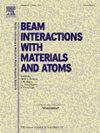Exploration of novel structure for high-power X-ray converter
IF 1.4
3区 物理与天体物理
Q3 INSTRUMENTS & INSTRUMENTATION
Nuclear Instruments & Methods in Physics Research Section B-beam Interactions With Materials and Atoms
Pub Date : 2025-05-02
DOI:10.1016/j.nimb.2025.165718
引用次数: 0
Abstract
The conversion of electron beams into X-rays with high penetration capability is an important technique in radiation processing. Previous designs of high-power X-ray converters sacrificed conversion efficiency to achieve high heat dissipation. In this study, a novel high-power converter structure was developed to improve the conversion efficiency of X-rays and reduce energy deposition in the converter. The structure involves vacuum welding of a tantalum plate onto a tooth-shaped copper plate with uniform thickness and forming multiple trapezoidal grooves between the tantalum and copper layers to serve as cooling channels. Geant4 simulation was employed to evaluate the power conversion when the converter was subjected to electron beam bombardment. The optimized converter reduced the loss of X-rays passing through it. Finite element analysis was performed to assess the temperature and deformation of the converter and determine the cooling parameters required to meet operational requirements. Based on the converter structure developed in this study, three potential tantalum–copper connection processes were analyzed, revealing superior performances with vacuum brazing. The novel X-ray converter has now been manufactured and assembled.
大功率x射线变换器新结构的探索
将电子束转换成具有高穿透能力的x射线是辐射处理中的一项重要技术。以前设计的高功率x射线转换器牺牲了转换效率来实现高散热。在本研究中,为了提高x射线的转换效率和减少能量沉积,开发了一种新型的大功率变换器结构。该结构包括将钽板真空焊接到具有均匀厚度的齿形铜板上,并在钽层和铜层之间形成多个梯形凹槽作为冷却通道。采用Geant4仿真计算了电子束轰击作用下转化器的功率转换。优化后的转换器减少了通过它的x射线的损耗。对转炉进行了有限元分析,以评估转炉的温度和变形,确定满足运行要求所需的冷却参数。基于本研究开发的转炉结构,分析了三种潜在的钽铜连接工艺,揭示了真空钎焊的优越性能。新型x射线变换器现已制造组装完成。
本文章由计算机程序翻译,如有差异,请以英文原文为准。
求助全文
约1分钟内获得全文
求助全文
来源期刊
CiteScore
2.80
自引率
7.70%
发文量
231
审稿时长
1.9 months
期刊介绍:
Section B of Nuclear Instruments and Methods in Physics Research covers all aspects of the interaction of energetic beams with atoms, molecules and aggregate forms of matter. This includes ion beam analysis and ion beam modification of materials as well as basic data of importance for these studies. Topics of general interest include: atomic collisions in solids, particle channelling, all aspects of collision cascades, the modification of materials by energetic beams, ion implantation, irradiation - induced changes in materials, the physics and chemistry of beam interactions and the analysis of materials by all forms of energetic radiation. Modification by ion, laser and electron beams for the study of electronic materials, metals, ceramics, insulators, polymers and other important and new materials systems are included. Related studies, such as the application of ion beam analysis to biological, archaeological and geological samples as well as applications to solve problems in planetary science are also welcome. Energetic beams of interest include atomic and molecular ions, neutrons, positrons and muons, plasmas directed at surfaces, electron and photon beams, including laser treated surfaces and studies of solids by photon radiation from rotating anodes, synchrotrons, etc. In addition, the interaction between various forms of radiation and radiation-induced deposition processes are relevant.

 求助内容:
求助内容: 应助结果提醒方式:
应助结果提醒方式:


